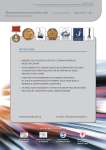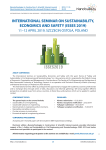Nanotechnologies in Construction: A Scientific Internet-Journal @nanobuild-en
Статьи журнала - Nanotechnologies in Construction: A Scientific Internet-Journal
Все статьи: 572
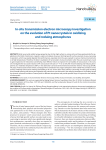
Статья научная
Metal nanocrystals exhibit unique properties due to their high surface-to-volume ratio and have great potential for applications in the fields of electronics, magnetics, optics and catalysis. However, their high specific surface area leads to easy coarsening in operation, which may greatly degrade their performances, especially when they are exposed to various chemical environments or at high temperatures. Therefore, the direct visualization of nanocrystals' structural evolution when they are coarsening is crucial to gain insight into the mechanism and develop more effective means to improve the size stability of nanocrystals. In this work, we investigated the structural evolution of Pt nanocrystals with sizes of ~ 4 nm on SiNx film in both oxidizing and reducing atmospheres at a moderate temperature (300оС) in the aberration-corrected environmental transmission electron microscopy (ETEM). The sizes of nanocrystals remain almost unchanged when annealed in the oxygen atmosphere with volatile PtOx formation on the surface, hindering nanocrystals sintering and leading to Pt loss. On the other hand, obvious coarsening of nanocrystals resulting from Ostwald-ripening and nanocrystal migration and coalescence was observed in the reducing atmosphere. Our findings reveal the dynamic structural evolution of nanocrystals in different atmospheres and provide possible ways to improve the size stability of nanocrystals.
Бесплатно
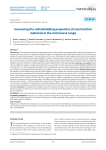
Increasing the radioshielding properties of construction materials in the microwave range
Статья научная
Introduction. The intensive development of technology in the modern world is accompanied by the origin of new types of manmade hazards, one of which is microwave radiation. Despite the considerable range of protective materials, not all of them are suitable for construction purposes. The main obstacle to their use is their high cost, and integrating them into the main types of wall construction materials would require significant changes to their production processes. The most practical and reasonable way to solve the issue is to introduce special additives into concretes and mortars traditionally used for the production of building products. The paper examines the effect of additives of fine-dispersed black carbon and aluminum powder in the composition of cement and gypsum matrices on radio shielding properties in the frequency range 1800–2800 MHz. Materials and methods. Black carbon powder was added to cement and gypsum paste in dosages of 0, 2.5, 5%, aluminum powder was added to gypsum paste in dosages of 0, 2.5, 5%. Superabsorbent polymers pre-saturated with water have been studied. Radio shielding properties have been studied on a designed experimental laboratory installation using a vector circuit analyzer NanoVNA. Results and discussion. The influence of black carbon and aluminum powder additives on the strength and microwave protective properties of gypsum and cement stone is considered. It is found that the addition of black carbon in an amount of up to 3–3.5% of the cement weight shows a neutral effect on the strength of cement stone, providing a decrease in the signal level of about 50% (–6 dB) observed in the ranges 1800–2100 MHz and 2300–2650 MHz, which makes this additive promising for solving the highlighted task. When additives are introduced into the gypsum matrix, the addition of black carbon reduces the radiation level to 60% (–8 dB), and aluminum powder to 69% (–10 dB) in a dosage of no more than 5% of the mass fraction of the binder on samples with a thickness of 3 cm. However, the additives considered have a noticeable negative effect on the strength characteristics of gypsum stone, which allows recommending the use of only black carbon in an amount of no more than 2.5% to obtain products that do not require high strength. Conclusion. The problems of creating construction materials to reduce the level of microwave radiation in the studied frequency range are outlined. Data have been obtained on increasing the shielding ability of cement and gypsum binders with the use of additives.
Бесплатно
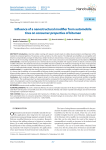
Influence of a nanostructural modifier from automobile tires on consumer properties of bitumen
Статья научная
Introduction. Used tire rubber cracking with organic solvents leads to rubber devulcanization and dispersion of the material to nanosized particles. The process can be carried out in a flow reactor. The obtained nanomodifiers are compatible with bitumen and predictably change the bituminous binder technical characteristics. Various practical solutions have been proposed for the use of the resulting modified bituminous binders in the road construction and strengthening soil foundations. Methods and materials. It has been proposed to use a method of joint cracking of rubber with organic solvents to obtain a nanostructured modifier of bitumen. The obtained nanostructural modifier has been studied by the methods of analyzing the sizes of nanoparticles and solubility in toluene. For the bituminous binders obtained with the use of nanomodifiers, standard characteristics for bitumen, such as needle penetration depth, softening temperature, brittleness temperature and extensibility have been determined. Results and discussion. It is established that during the proposed process, a nanostructural modifier compatible with bitumen is formed. It is shown that the addition of a nanomodifier to bitumen makes it possible to purposefully change the properties of the resulting bitumen binder, improve the consumer properties of the bitumen binder and expand its application areas. It is proposed to use the obtained product as a component of waterproofing mastics for waterproofing the underground parts of buildings and structures. Conclusion. Joint cracking of rubber with organic solvents in a flow reactor allows obtaining a nanostructural modifier compatible with bitumen. The resulting product has improved properties compared to the original bitumen, which expands its scope of application. It is proposed to use the resulting product for the manufacture of waterproofing mastics. The proposed technical solutions make it possible to reduce the environmental load of automobile tires wastes.
Бесплатно
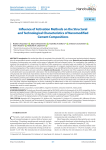
Статья научная
Introduction. We studied the effect of nanosized silicon dioxide (SiO2) on the structural and technological characteristics of nanomodified cement compositions introduced together with activated mixing water. Materials and research methods. Activation of mixing water was carried out by means of magnetic field and ultrasonic action. For investigation the capability to maintain their properties for a long time, the stability of silica suspensions in activated water was studied. For finding out the effect of activated silica suspensions on the structure and properties of composite materials based on cement, the physical and mechanical properties of the studied compositions were explored. X-ray and differential thermal analysis of the hardened activated nanomodified cement paste were also carried out. Results and discussion. The positive role of the suspension of silicon dioxide in activated water was associated with a decrease in the microheterogeneity of the hardened cement paste, ensuring the stability of its physical and mechanical characteristics. Based on the above mentioned observations, a mechanism was proposed for more efficient incorporation of nanosized silicon dioxide into cement hydration processes both due to chemisorption with Ca(OH)2 in the hardening cement paste and due to the topological effect of nanoparticle localization in defects and ultramicrovoids of a crystallizing disperse system. Conclusion. The results show that suspensions of silica in activated water can maintain their properties for a long time. Graphical dependencies are shown, indicating the effectiveness of the use of activated silica suspensions in the production of cement composites. This quality makes it possible to obtain repair compounds with the required properties during construction work for various purposes.
Бесплатно

Influence of high-dispersive powder mixture of WC and TiC on the composite materials properties
Статья научная
Introduction. The purpose of the research is to study the effect of a high-dispersive powder mixture of WC, TiC, obtained from recycling of hard-alloy manufactured articles from TK group (titanium-tungsten alloys), on the change in the structural and physical and mechanical properties of cement materials. Materials and research methods. WC, TiC Powder (particle size 20–150 nm, agglomerates 300 nm – 1.5 μm) was added to the cement mortar by partial replacement of cement in various concentrations of 0%, 1%, 2%, 3%, 4%, 5% by mass. The basic physical and mechanical properties of the cement paste and obtained cement materials were studied in accordance with standard methods, taking into account regulatory documents of Russian and foreign standards. Thermokinetic, X-ray phase analysis, scanning electron microscope investigation with an integrated system of energy-dispersive analysis were also applied. Results and discussion. It has been proved that highly dispersed WC, TiC powder additive to cement materials leads to increase in density, paste fluidity, reduction in setting time, decrease in water absorption, porosity, and increase in strength characteristics both in early and later periods of hardening. A highly dispersed additive promotes earlier hydration. The structure of the cement sample with powder additive is denser throughout the considered periods of hardening compared to the control sample. Conclusion. The obtained results are of great importance for understanding the action mechanism on cement materials of highly-dispersed particles of WC, TiC, which can later be used to improve the properties of composite cement-based materials in various fields of application.
Бесплатно
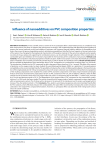
Influence of nanoadditives on PVC composition properties
Статья научная
Introduction. In this scientific article a scheme of the no synergistic effect is observedion process is considered. It has been shown that to slow down or suppress the main process occurring in the condensed phase and determining the formation of gaseous fuel several methods can be used: addition of polymers with increased thermal stability; addition of nanoadditives that reduce the amount of gaseous degradation products; introducing nanoadditives that affect the heat capacity or thermal conductivity of the system, thus changing the thermophysical characteristics of the polymer material. At the same time reduced reaction speeds, occurring in the gas phase and supporting the combustion process, can be achieved through reduction of the concentration of combustible gases and inhibition of the reactions responsible for the branching of the combustion chain process. Methods and materials. The composition and physical properties of kaolin are given. Kaolin monocrystal is a two-layer aluminosilicate containing water of hydration and consisting of chemically bonded layers of silicon dioxide and hydrated alumina. Results and discussion. We have studied the dependence of the attenuation time of a PVC composition on a composition containing from 3 to 10% kaolin. The introduction of kaolin into the PVC compound has led to decrease of decay time from 4.5 to 1 seconds. The effect of the amount of plasticizer on the oxygen index has been studied. We used dibutoxyethyl adipate (DBEA) as a plasticizer. It has good polymer compatibility and is environmentally friendly. The possibility of reducing the content of dibutoxyethyl adipate in the basic formulation of the original plasticate I40-13A by increasing the amount of calcium carbonate was studied, then the performance properties of the resulting compositions were studied. The content of PVC and other components in the basic recipe remained unchanged. Analysis of the data showed that for plasticization of 62% wt PVC contained in I40-13A, 20% wt DBEA is sufficient, while the filler content can be increased at least twice. The oxygen index (OI) value at a component ratio of 20% DBEA + 13.56% CaCO3 increases by 4 OI units and becomes equal to 29.1%. The dependence of the oxygen index of PVC compound on the composition containing from 5 to 20% kaolin has been studied. The results showed that the oxygen index of plastic compound increases significantly with increasing kaolin content. The OI drops with a decrease in the amount of the introduced, and it remains unchanged with its increase. Thus, the optimal content is 15%. Conclusion. Thus, kaolin is a promising, inexpensive and environmentally friendly filler for PVC materials, which effectively reduces their combustibility. The same effect is achieved by increasing the content of calcium carbonate in the original PVC compound formulation. However, no synergistic effect was observed while mixing kaolin and an excess of calcium carbonate.
Бесплатно
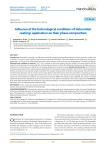
Статья научная
Introduction. Detonation spraying is an effective method for applying high-quality coatings to various materials, widely used in industry to improve wear resistance and corrosion resistance of surfaces. This article examines the influence of key process parameters, such as gun-to-substrate distance and nozzle velocity, on the structure and properties of the resulting coatings. Materials and methods of research. The Ti–TiO2 coatings on hot-rolled carbon steel are studied. The spray distance and the speed of nozzle passage are varied while the rest spraying parameters are fixed. The obtained coatings were studied using scanning electron microscopy, X-ray diffraction, and energy-dispersive X-ray spectroscopy. Results and discussion. It is found that the phase composition of the coating changes depending on the detonation spray conditions. The fraction of rutile exceeds the fraction of anatase in the obtained samples except for the samples obtained with the fastest nozzle passage. The rutile fraction monotonically decreases with an increase in the spray distance with fixed values of the rest parameters of spraying process. It is found a nonmonotonic changing the rutile fraction with an increase in the speed of nozzle passage and found its optimal values. Two new theoretical models for the spray process based on differential equations are proposed, the solutions of which sufficiently describe the dependencies of the rutile fraction on the distance and speed of the nozzle, respectively. Conclusion. It has been demonstrated that the theoretical values of the parameters, calculated using the formulated equations, are in good agreement with the experimentally measured values.
Бесплатно
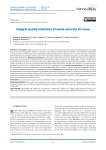
Integral quality indicators of waste concrete for reuse
Статья научная
Introduction. Waste concrete is one of the main heavy construction waste having good recycling prospects with regard to rational nature management related to reducing the consumption of natural resources. However, the widespread introduction of waste concrete is hindered on the one hand by the variety of compositions and structures of recycled scrap, and on the other hand by the lack of quantitative criteria to choose the most rational area of its use (a binder component, coarse and fine aggregate, finely dispersed filler, etc.). Materials and methods. Case studies of experimental powders obtained by mechanical grinding from the concrete scrap of internal wall panels and floor slabs (heavy concrete) and external wall panels (light concrete) of a five-storey residential panel house built in 1979 in the Obozersky village, Arkhangelsk region, demonstrated the possibility of choosing the optimal secondary use of waste concrete fractions featuring residual compressive strength. The indicators of residual strength, grindability and contraction of mineral powders were used as optimization criteria. Results and discussions. The applicability of the mathematical model for calculating the raw material grindability index is shown. A criterion for grinding equipment selection is proposed to obtain powders with an extended active surface. Conclusions. Powders obtained from the fraction of waste light concrete featuring low strength properties and grindability by mechanical grinding to a specific surface area comparable to that of Portland cement used and having a higher value of contraction can be rationally used as a composite binder component. Concrete scrap fractions featuring by higher grindability and strength properties are optimally suited for crushed aggregate preparation in the concrete composite production process.
Бесплатно
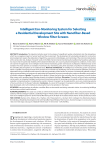
Статья научная
Introduction. The industrial activities result in the release of a significant number of pollutants into the atmosphere, which have a negative impact on human health and the environment. The development of sustainable principles for construction sites development requires the elaboration of algorithms, assessment methodologies, and monitoring of the environmental situation at the construction site. Analysis of research works in the field of environmental monitoring of air pollution by hazardous substances has shown that the speed and reliability of the obtained information are crucial in polluted atmospheric conditions. In this article, we examine the application of an intelligent environmental monitoring system with Salavat city Republic of Bashkortostan as the example. The article presents an example of continuous eco-monitoring using three automatic air pollution monitoring stations for controlling the atmospheric air in residential areas. Methods and Materials. An intelligent eco-monitoring system is proposed, which is capable of assessing the state of the air basin of an industrial city, identifying sources of increased air pollution, processing information using an artificial neural network in real-time, generating control actions on sources of increased air pollution, and providing recommendations to businesses for optimizing their operations to prevent exceeding the maximum allowable concentrations of harmful substances. Results. The analysis of air quality in Salavat has led to the conclusion that it is necessary to install window filter-screens with nanofiber-based filtering elements in residential buildings. Discussion. The results of the air basin monitoring can be used in an integrated intelligent environmental monitoring system for assessing environmental conditions and can be made available to interested parties. Considering the results in Salavat, the project can be replicated for use in eco-monitoring systems of towns and cities in the Russian Federation. Conclusion. As a result of the project, the program utilizing artificial intelligence has been developed, which will contribute to reducing the level of air pollution in the future.
Бесплатно

